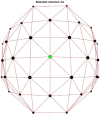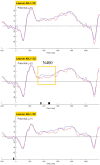Memory systems modulate crosslinguistic influence on third language morphosyntactic acquisition
- PMID: 38990861
- PMCID: PMC11238999
- DOI: 10.1371/journal.pone.0304572
Memory systems modulate crosslinguistic influence on third language morphosyntactic acquisition
Abstract
Previous studies on crosslinguistic influence (CLI) on third language (L3) morphosyntactic acquisition have provided support for competing theories about the source(s) of CLI. The present study aimed to test if both L1 and L2 can be the source of CLI, and whether they influence L3 learning in similar or different ways. In particular, we aimed to add to our knowledge of the neural correlates of CLI by conducting an exploratory EEG study to investigate how L1 and L2 CLI affect L3 neural processing. Predictions based on the D/P model, which posited different memory systems sustaining L1 and L2, were tested. The findings confirmed both L1-sourced and L2-sourced facilitation on L3 morphosyntactic acquisition. Specifically, we suggest that L1-similarity showed a consolidating effect on L3 implicit knowledge and neurocognitive internalization, whereas L2-similarity contributed to enhanced L3 metalinguistic knowledge. This preliminary study is the first to investigate the neurocognitive mechanisms underlying CLI in L3 learning by natural language learners.
Copyright: © 2024 Xu et al. This is an open access article distributed under the terms of the Creative Commons Attribution License, which permits unrestricted use, distribution, and reproduction in any medium, provided the original author and source are credited.
Conflict of interest statement
The authors have declared that no competing interests exist.
Figures























References
-
- MacWhinney B. The competition model: Past and future. In: Language, Cognition, and Mind. Cham: Springer International Publishing; 2022. p. 3–16.
-
- Ullman MT. The Declarative/Procedural Model: A Neurobiologically-Motivated Theory of First and Second Language. In: Vanpatten B, Keating GD, Wulff S, editors. Theories in Second Language Acquisition. 2020. p. 128–61.
-
- Murphy S. Second language transfer during third language acquisition. Studies in Applied Linguistics and TESOL [Internet]. 2003;3(2). Available from: 10.7916/SALT.V3I2.1625. - DOI
-
- Puig-Mayenco E, González Alonso J, Rothman J. A systematic review of transfer studies in third language acquisition. Second Lang Res [Internet]. 2020;36(1):31–64. Available from: 10.1177/0267658318809147. - DOI
-
- Sánchez L. L2 activation and blending in third language acquisition: Evidence of crosslinguistic influence from the L2 in a longitudinal study on the acquisition of L3 English. Biling (Camb Engl) [Internet]. 2015;18(2):252–69. Available from: 10.1017/s1366728914000091. - DOI
MeSH terms
LinkOut - more resources
Full Text Sources
Medical
Research Materials
Miscellaneous

